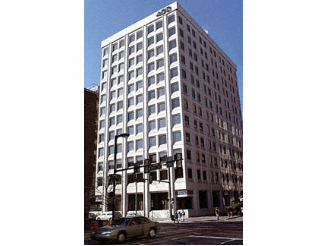Earlier this month, President Obama unveiled the Better Building Initiative (BBI), a public-private partnership that will invest $4 billion toward making federal and commercial office buildings more energy-efficient.
400 Market Street, an 11-story Philadelphia office tower built in 1972, is already serving as a model for how owners of hundreds of older, mid- and high-rise buildings throughout the Northeast and Midwest can reap the benefits of the program.
The 200,000 sf building, home to Philadelphia’s high-powered KWY-AM radio station, was recently renovated with a new HVAC system and a state-of-the-art window retrofitting system called RENOVATE by Berkowitz. According to energy modeling studies conducted with the U.S. Department of Energy’s most sophisticated energy modeling software, a typical 10- to 15-story office building like 400 Market Street could realize significant energy savings.
Developed by J.E. Berkowitz, a glass fabricator based in Pedricktown, N.J., the system works by converting existing single-pane windows into energy-saving, triple-glazed insulating glass units (IGUs) at a cost that is up to 50 percent less than ripping out and replacing old windows with new ones.
The window renovation system also has the benefit of being much faster and less disruptive to install. Berkowitz said the retrofit project for 400 Market Street took about 50 working days, which is two to three times faster than it would have been for a traditional “rip-out-and-replace” project for a similarly sized building. In addition, because the retrofitting was completed indoors, tenants were able to remain in their offices throughout the project. That is not possible with traditional window retrofitting solutions.
The BBI, which was first announced in January 2011, was developed to increase the energy efficiency in commercial buildings by 20 percent by 2020. Under the BBI, 60 private companies, municipal leaders and labor organizers have agreed on a plan to invest $2 billion of private capital to improve commercial, industrial, and manufacturing property. President Obama authorized the government to move forward with another $2 billion in energy-efficiency upgrades to federal buildings, which will be paid for by the long-term savings that the upgrades will provide. BD+C
Related Stories
| Sep 13, 2010
World's busiest land port also to be its greenest
A larger, more efficient, and supergreen border crossing facility is planned for the San Ysidro (Calif.) Port of Entry to better handle the more than 100,000 people who cross the U.S.-Mexico border there each day.
| Sep 13, 2010
Triple-LEED for Engineering Firm's HQ
With more than 250 LEED projects in the works, Enermodal Engineering is Canada's most prolific green building consulting firm. In 2007, with the firm outgrowing its home office in Kitchener, Ont., the decision was made go all out with a new green building. The goal: triple Platinum for New Construction, Commercial Interiors, and Existing Buildings: O&M.
| Sep 13, 2010
Stadium Scores Big with Cowboys' Fans
Jerry Jones, controversial billionaire owner of the Dallas Cowboys, wanted the team's new stadium in Arlington, Texas, to really amp up the fan experience. The organization spent $1.2 billion building a massive three-million-sf arena that seats 80,000 (with room for another 20,000) and has more than 300 private suites, some at field level-a first for an NFL stadium.
| Sep 13, 2010
'A Model for the Entire Industry'
How a university and its Building Team forged a relationship with 'the toughest building authority in the country' to bring a replacement hospital in early and under budget.
| Sep 13, 2010
Committed to the Core
How a forward-looking city government, a growth-minded university, a developer with vision, and a determined Building Team are breathing life into downtown Phoenix.
| Sep 13, 2010
Conquering a Mountain of Construction Challenges
Brutal winter weather, shortages of materials, escalating costs, occasional visits from the local bear population-all these were joys this Building Team experienced working a new resort high up in the Sierra Nevada.
| Sep 13, 2010
Data Centers Keeping Energy, Security in Check
Power consumption for data centers doubled from 2000 and 2006, and it is anticipated to double again by 2011, making these mission-critical facilities the nation's largest commercial user of electric power. With major technology companies investing heavily in new data centers, it's no wonder Building Teams see these mission-critical facilities as a golden opportunity, and why they are working hard to keep energy costs at data centers in check.
| Sep 13, 2010
3D Prototyping Goes Low-cost
Today’s less costly 3D color printers are attracting the attention of AEC firms looking to rapidly prototype designs and communicate design intent to clients.
| Aug 11, 2010
Cubellis principals reorganize as CI design
Former principals of Cubellis Inc. have formed ci design "with a stellar group of projects in the United States and internationally," states John Larsen who, with Richard Rankin and Christopher Ladd, is leading the architecture and planning firm.
| Aug 11, 2010
Leo A Daly changes name of STH, completes acquisition
LEO A DALY has changed the name of STH Architectural Group to the name of its parent company, Leo A Daly. STH was acquired in February 2009 as a strategic move to accelerate growth in its core business sectors and to strengthen the firm's presence in the Florida market.















